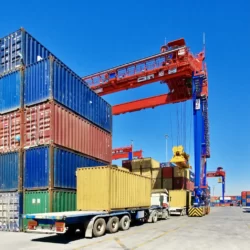Digitization: frontrunners extend their lead

Many companies say they are digitizing their supply chain, but their words don’t translate into deeds. As a result, they are continually falling further behind the frontrunners. During a recent Supply Chain Media Webinar Wednesday, Flexport’s Mathijs Slangen urged these laggards to take action. “If you’re too slow to act, you will lose out to the competition.”
By Marcel te Lindert
Transporting goods from one side of the world to the other is far from easy. The process involves lots of manual activities and therefore a high risk of errors, which means that a lot of time is wasted on fire-fighting and correcting mistakes. Another consequence is that many documents and data cannot be effectively digitized and analysed, making it difficult to identify trends. Moreover, the communication between the stakeholders often leaves a lot to be desired.
There are clearly plenty of reasons to digitize the whole process… and yet many companies are still not doing so. “Every company says that digitization is the future, but there’s a difference between what companies say and what they actually do,” stated Mathijs Slangen. He is responsible for marketing & sales in Europe at Flexport, a San Francisco-based digital forwarder. “Many businesses want to digitize their supply chain and are willing to pay a little more for that. But there are also companies that would like to digitize, but then say that we’re 7% too expensive. Those are the companies that say they want to digitize, but ultimately opt for a more traditional, cheaper solution.”
Gap between frontrunners and laggards
Slangen urged such companies to nevertheless make a start on digitizing their supply chain. He referred to the frontrunners – those who are serious about the topic and are actually investing in it. “They have set the wheels in motion, and the momentum is now building. These frontrunners are increasingly benefiting from their efforts and are therefore extending the gap between themselves and the laggards who, if they don’t act soon, will ultimately have to give up.”
The laggards seem to be forgetting about the network effect. After all, numerous partners are involved in transporting goods from Asia to Europe – from freight forwarders and carriers, to ports and customs authorities. Companies who only focus on one part of the network will miss out on many other opportunities. “Ultimately, it’s about connecting the entire network. That may not succeed from Day One, but it should be the goal,” Slangen explained.
Over-ambitious
Another hurdle is that many companies see supply chain visibility as the end goal rather than as the means to an end. They might know exactly where their goods are, but what do they do with that knowledge? “You need to know who is going to act. Who picks up the phone if it turns out your goods are stuck in Singapore?” Slangen asked. “Another problem is the quality of the data used. If the right data isn’t available, decisions will be too slow or might not even get made at all.”
According to Slangen, many businesses are over-ambitious. Once they have decided to digitize their supply chain, they draw up lengthy lists of requirements that all need to be in place from Day One. “Remember that every digitization project has a bumpy start. Companies have to keep their manual processes going and invest in digitization at the same time. As a result, the costs can soon mount up in the beginning. Companies have to clear the initial bumps before they can automate the processes and start making the data work for them.”
Fast response to disruptions
Digitization is particularly vital nowadays. Many companies are currently facing a declining market, which is intensifying competition. To maintain their market share, businesses must be able to respond quickly to supply chain disruptions. Failure to get products onto shelves on time means you lose out to the competition. “Three factors are key for responsiveness. Firstly, it’s important to have a lot of high-quality and highly detailed data. Only then can you learn from historical data and identify trends. That’s the principle at the heart of artificial intelligence.”
Secondly, robust processes are needed. If the available data indicates that it is better to avoid a particular port, for example, that information must be acted on and implemented. And thirdly, all actions must be visible and traceable for everyone involved, so they know what is going to happen: “That’s how you build end-to-end supply chain integration.”
Automating as well as digitizing
During the webinar, Slangen highlighted a number of companies that have made great strides by digitizing their supply chain. One is a healthcare firm that no longer wastes valuable time on checking carriers’ invoices, and another is a sports brand that has eliminated lots of delays by digitizing its handling of customs formalities. “And one of our customers is a global food company with lots of different ERP systems, which made it difficult to create visibility. Instead of implementing a new ERP system globally, they chose to connect their existing ERP systems through our platform.”
So how can you ensure that you too become a frontrunner, like these three companies? Slangen gave a three-pronged answer: “First, make sure you have the right data. Then create a digital model of all the physical objects or attributes, and use that data to not only digitize but also automate processes. And lastly, consider the network effect. Connect as many parties as possible to the digital platform. You don’t have to do that right from the start, but it should be part of the growth path. You must safeguard all three of these elements. If you don’t, you’ll be pretty disappointed in the impact of your digitization strategy.”










